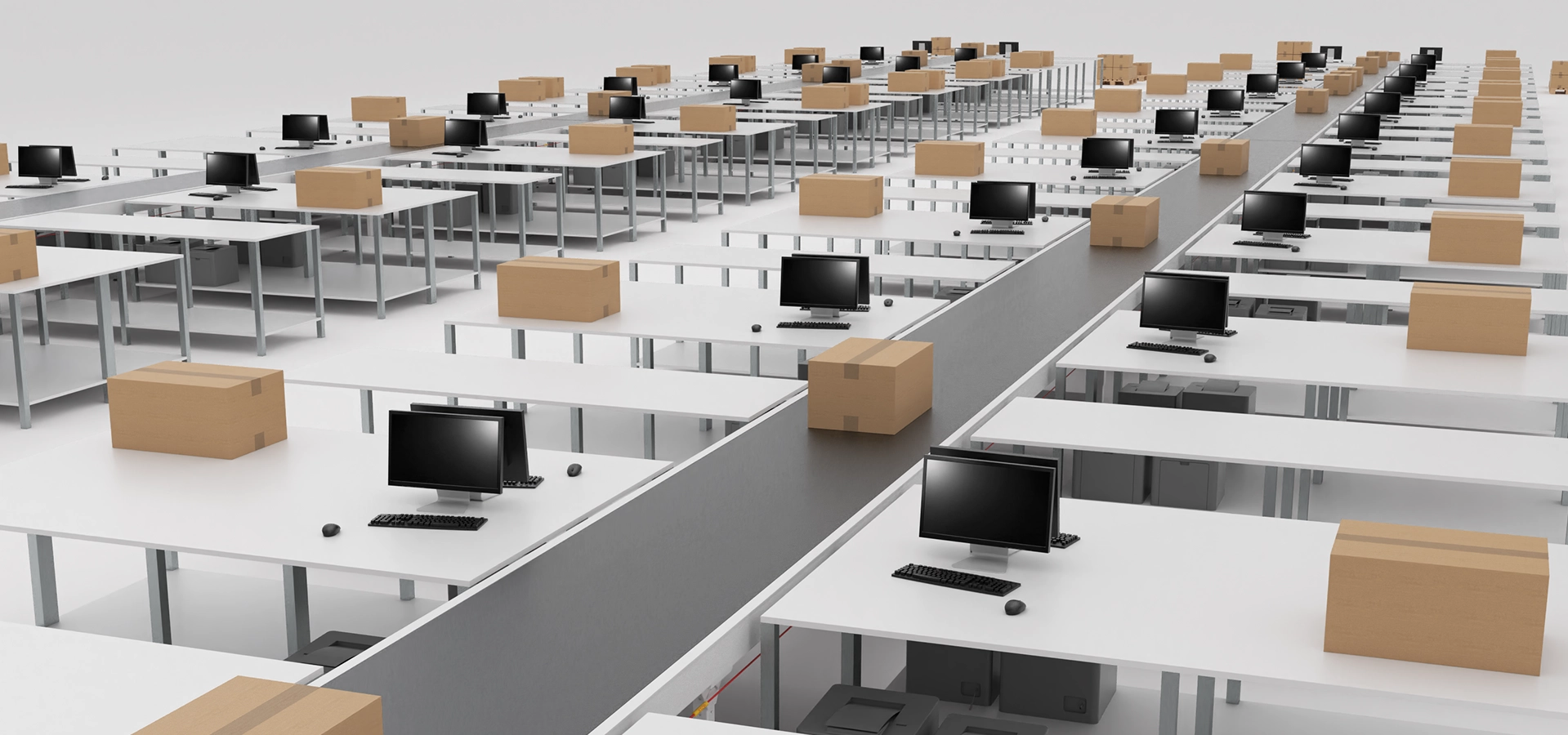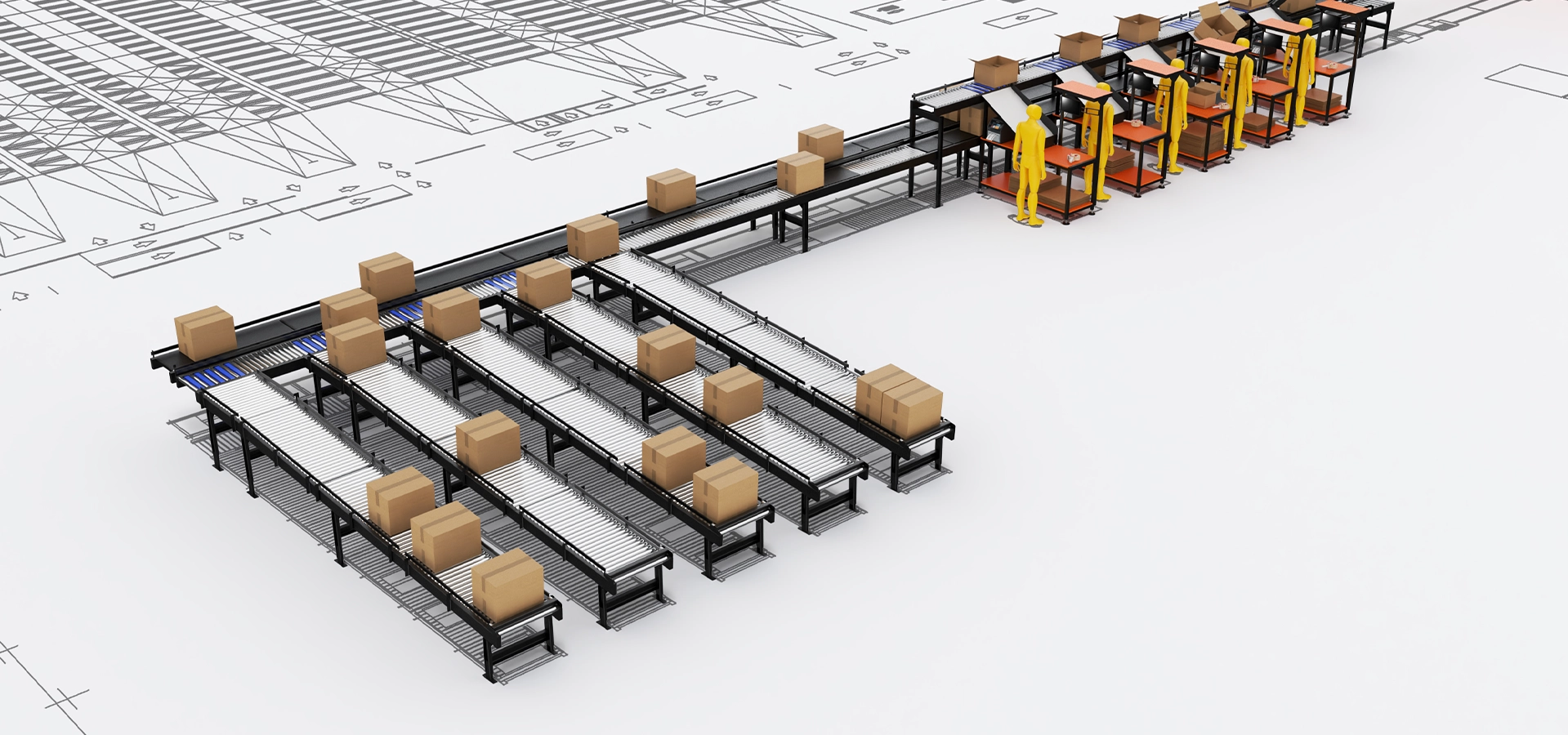
Technological advances and new market dynamics have changed the way warehouses operate. Increased demand and high demands on delivery times have implied a restructuring of processes within logistics centers, where new technologies have been incorporated to meet these challenges.
One of the great acquisitions to streamline production lines have been industrial conveyor belts. In this post we will see what industrial conveyor belts are, what their advantages are and how Rielec can help you to enhance your warehouse processes.
What are industrial conveyor belts?
An industrial conveyor belt is a system designed to move goods from one place to another. It is used to optimize many of the processes that were previously done manually. They are versatile as they have multiple applications and can be adapted to different environments and terrains. Below we will detail the main benefits of their use.
When should we use industrial conveyor belts?
Industrial conveyor belts can be used in any production process. Thanks to their characteristics it is possible to design efficient ad hoc material conveying lines that bring businesses numerous advantages. They are usually used to transport the following contents:
- Materials, such as minerals, seeds, foodstuffs or coal.
- Boxes or parcels, especially in logistics centers
- Loading and unloading of cargo vessels or trucks
- Transport of materials on inclined terrain.
What are the benefits of using conveyor belts?
There are different types of conveyor belts depending on the need of the process, but, in general terms, the use of this resource brings the following benefits:
- It facilitates the work, saving time and effort.
- Increases work capacity thanks to the automation of its transport.
- It allows the automated transport of materials over long distances and in large quantities, thus reducing operator effort.
- It can be used for any type of material that comes in boxes.
- Allows loading and unloading at any point along the route.
- Reduces the risk of alterations in transported products.
- It consumes less energy than other transportation systems.
Conveyor belts are very easy to use and have low maintenance costs. As a rugged product, they have a long service life. But most importantly, they improve working conditions for employees, increase productivity and reduce costs for the company.
The following are examples of when they are used in a warehouse.

Examples of the use of industrial conveyor belts in warehouses
The conveyor belt system can be installed in various industries regardless of the warehouse layout, as it is a solution that can be custom-designed.
From Rielec we offer industrial conveyor belts for boxes, packages, plastic buckets or bagged products that are transported in boxes. Its main applications are:
- Reception, distribution and dispatch of boxes or packages.
- Connection between the different zones of the tank (circuit or automatic flow of boxes).
- Union between the different floors and heights of the warehouse.
- Warehouse entry and exit point to promote automatic flow.
- Long distance conveying system separating operational areas (e.g.: receiving of boxes, material input, output for loading)
Application levels of industrial conveyor belts
We can classify warehouses into three types: conventional warehouses, automated warehouses and warehouses in need of retrofitting.
Conventional warehouses are those where the movement, handling and storage of goods is carried out manually or with traditional forklifts.
When the entry of goods or the handling of boxes begins to require more space or agility, it is convenient to apply the use of these industrial conveyor systems. In this way, the use of conveyor belts will help the different operators to trace less route and to dedicate themselves to more punctual tasks in the different areas of the transport.
Warehouses that already have a belt conveyor system but their own installation requires further optimization, either due to an increase in goods or a better flow arrangement, may need what we call a retrofit in which, through coordination with previous suppliers, we take care of complementing the current installation with a new flow that meets the needs of the warehouse.
In the same way, from Rielec we can perform a retrofit with the use of different robots such as box formers or sorters according to the size of the goods.
Automated warehouses usually already have a conveyor belt system; in many cases we also find automated flows containing industrial robots. In this way, the operator's work and effort is reduced to very specific tasks that reduce or eliminate wasted time, thus improving productivity.
Today it is very difficult to find a single supplier that offers a set of elements, robots and solutions that meet all the needs of an automated intralogistics process.
The most complete solution is to coordinate different suppliers in the same project based on these needs. From Rielec we collaborate with the different teams either in automation or retrofit processes, always thinking about the final solution that the customer needs.
Each tank may have varying degrees of automation or none at all. However, conveyor belts can adapt to the existing layout or create a new one, depending on the initial conditions. They are often one of the first resources adopted when designing automation from scratch or when performing an expansion or retrofit. The conveyor belt system to be chosen will depend on the intended use, the material to be conveyed, the environment and the process requirements, such as how safe, fast or efficient it must be.
Industrial belt conveyors
Belt conveyor belts consist of a belt between two drums that, thanks to a motor, is in continuous motion. How do they work? One of the two drums generates friction, and this friction causes the belt to circulate. The other drum serves as a return to the belt and rotates freely.
Types of industrial belt conveyors
Depending on the type of the section to be covered, the appropriate type of belt conveyor must be selected. There is a wide variety, each differing in their mode of operation and conveying direction.
Straight belt conveyors
This is the most commonly used type of band. Ideal when space is available and you want to connect one point to another in a straight line.
Merge belt conveyors
The merge is a belt conveyor with an oblique transitional edge and with a
angle of 30° or 45°. This conveying element makes it possible to concentrate two lines of
transport at the corresponding angle. Using sorting elements
additional, transport flows can also be separated.
Curved belt conveyors
Curved belt conveyors are used especially when space inside the warehouse is limited. Thanks to its flexibility, the space is maximized, ensuring an optimal route. This type of belt conveyor is installed with angles between 45º, 90º and 180º.
Belt conveyors with top and bottom feed
Belt conveyors with feed are used to move all types of goods on ramps and inclines. Smooth and quiet running can be achieved on the upper and lower bends thanks to the arch and the feed.
Straight belt conveyors with accumulation
Industrial roller conveyors
Roller conveyor belts are made up of circular tubes that rotate on themselves at the same speed and in the same direction. They are ideal for transporting boxes and packages.
This type of belt has three drive options: freewheeling, gravity or motorized. Which one to choose will depend on the function required and the desired conveyor speed.
At Rielec we have two types of roller conveyors: VDC roller conveyors and functional roller conveyors. Depending on the customer's needs we determine which of the two options is the best for the project. You can see our roller conveyors here.
Rielec intralogistics: we manufacture our industrial conveyor belts
At Rielec we manufacture customized intralogistics solutions so that you can improve the efficiency of your warehouse. We have a wide range of conveyor belts for industrial use that we integrate into your existing or new processes. We take care of their manufacture and assembly, but our after-sales service also allows us to accompany you even when the work has already been completed. If you want to know more about our conveyor belts in retail warehouses or distribution centers, you can contact us here.